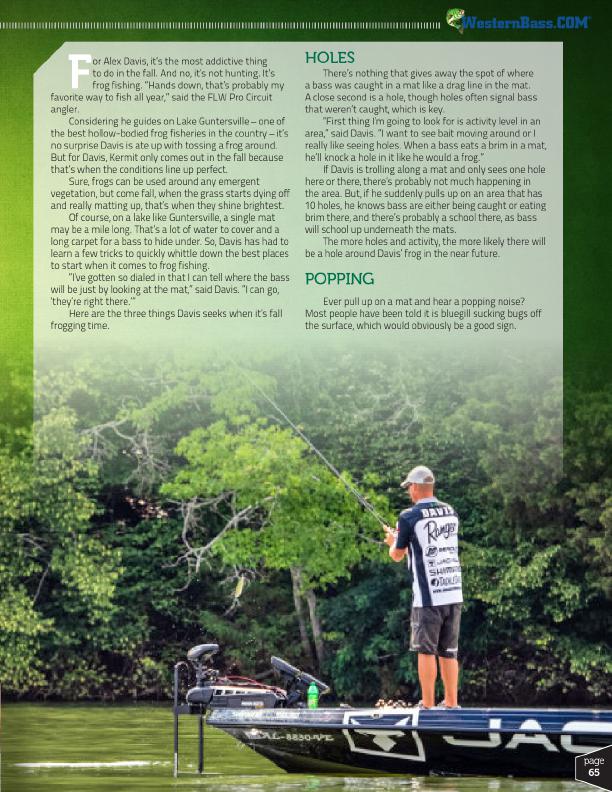
F
or Alex Davis, it’s the most addictive thing
to do in the fall. And no, it’s not hunting. It’s
frog fishing. “Hands down, that’s probably my favorite way to fish all year,” said the FLW Pro Circuit
angler.
Considering he guides on Lake Guntersville – one of
the best hollow-bodied frog fisheries in the country – it’s
no surprise Davis is ate up with tossing a frog around.
But for Davis, Kermit only comes out in the fall because
that’s when the conditions line up perfect.
Sure, frogs can be used around any emergent
vegetation, but come fall, when the grass starts dying off
and really matting up, that’s when they shine brightest.
Of course, on a lake like Guntersville, a single mat
may be a mile long. That’s a lot of water to cover and a
long carpet for a bass to hide under. So, Davis has had to
learn a few tricks to quickly whittle down the best places
to start when it comes to frog fishing.
“I’ve gotten so dialed in that I can tell where the bass
will be just by looking at the mat,” said Davis. “I can go,
‘they’re right there.’”
Here are the three things Davis seeks when it’s fall
frogging time.
HOLES
There’s nothing that gives away the spot of where a bass was caught in a mat like a drag line in the mat. A close second is a hole, though holes often signal bass that weren’t caught, which is key.
“First thing I’m going to look for is activity level in an area,” said Davis. “I want to see bait moving around or I really like seeing holes. When a bass eats a brim in a mat, he’ll knock a hole in it like he would a frog.”
If Davis is trolling along a mat and only sees one hole here or there, there’s probably not much happening in the area. But, if he suddenly pulls up on an area that has 10 holes, he knows bass are either being caught or eating brim there, and there’s probably a school there, as bass will school up underneath the mats.
The more holes and activity, the more likely there will be a hole around Davis’ frog in the near future.
POPPING
Ever pull up on a mat and hear a popping noise? Most people have been told it is bluegill sucking bugs off the surface, which would obviously be a good sign.
®
page 65